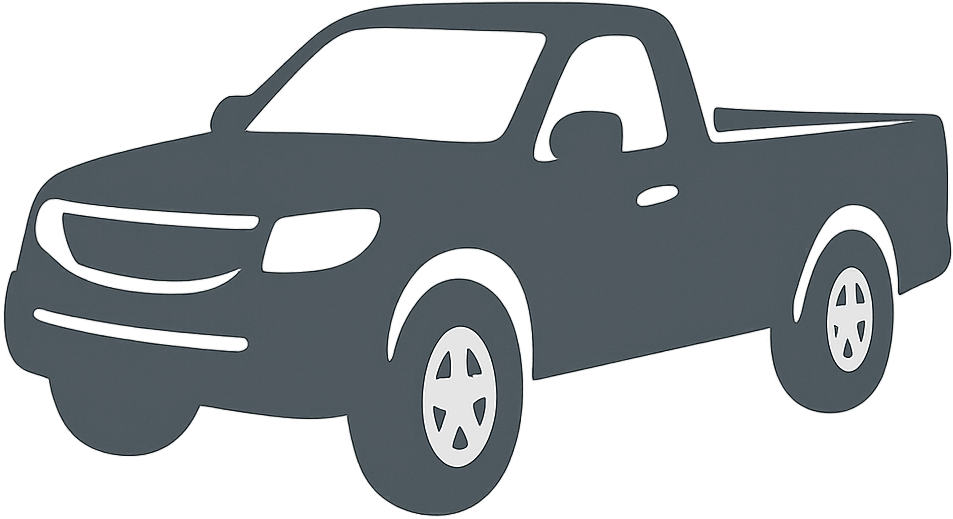 1972 Renault Rodeo 6 Dimensions, Size & Specs
1972 Renault Rodeo 6 Dimensions, Size & Specs
The Renault Rodeo 6 is a distinctive compact pickup truck produced from 1972 to 1981, known for its versatile design and utilitarian appeal. As part of the Rodeo series, this generation delivered practical transport solutions in a small package ideally suited for both rural and urban use. The Rodeo 6 combined the robustness expected from a pickup truck with the maneuverability of a compact vehicle. It featured a lightweight body built on a modified Renault platform, allowing it to handle diverse terrains while maintaining fuel efficiency.
While exact dimensions can vary slightly depending on specific configurations, the Rodeo 6 generally measured around 3.88 meters (approximately 12.7 feet) in length, with a width near 1.58 meters (about 5.2 feet), and a height close to 1.51 meters (4.95 feet). Its compact size made it easy to park and navigate through tight spaces compared to larger pickups of its era. The lightweight frame contributed to a curb weight typically under 1,000 kilograms (2,205 lbs), which improved performance and handling.
The Renault Rodeo 6 was favored for its simple yet functional design, offering a small cargo bed suitable for light loads — perfect for farmers, artisans, and small business owners seeking a reliable work vehicle. Its pickup body style granted versatility not only for cargo transport but also for recreational use. Over the production period from 1972 to 1981, the Rodeo 6 stood out as an economical option amid other larger and heavier trucks, with a charming blend of practicality and French automotive style.
Today, the Renault Rodeo 6 remains a notable classic vehicle, appreciated by collectors and enthusiasts who value its unique mix of compactness, utility, and vintage appeal. Its manageable size and lightweight nature continue to make it an interesting subject for comparison among historic pickup trucks, especially those from the 1970s.
Discover the standout features that make the 1972 Renault Rodeo 6 a leader in its class
Have a question? Please check our knowledgebase first.
The Renault Rodeo 6, produced from 1972 to 1981, is a compact pickup characterized by modest exterior dimensions suitable for light utility use. While exact factory dimensions can vary slightly depending on specific configurations, the Rodeo 6 typically measures approximately 3.80 meters (149.6 inches) in length, about 1.50 meters (59.1 inches) in width, and a height near 1.60 meters (63.0 inches). These dimensions reflect its design as a small, rugged utility vehicle optimized for efficient maneuverability and ease of parking, particularly in rural or off-road environments where space can be limited.
The Renault Rodeo 6 is relatively lightweight, with a curb weight of approximately 800 to 900 kilograms (1764 to 1984 pounds), depending on the exact version and equipment. The pickup was designed for light duty, typically offering a payload capacity around 500 kilograms (1102 pounds). This balance between weight and payload made the Rodeo 6 practical for agricultural, light commercial, or recreational use while maintaining decent fuel economy and easy drivability.
As a compact utility vehicle from the 1970s, the Renault Rodeo 6 provides a minimalist and functional cabin rather than the spacious interiors seen in modern pickups. Seating capacity is generally for two or three occupants with limited legroom and headroom by today’s standards. The focus was on simplicity and utility rather than comfort or luxury. Modern pickups tend to be larger, offering more advanced features, increased space, and ergonomic design improvements that create more comfortable driving experiences.
Yes, the Renault Rodeo 6 is compact enough to fit comfortably into a standard modern garage. Given its length of around 3.80 meters (149.6 inches) and width approximately 1.50 meters (59.1 inches), it is smaller than most contemporary vehicles. Typical garages, which accommodate cars roughly 5 to 6 meters (196 to 236 inches) in length and wider than 2.5 meters (98 inches) in width, provide ample space for the Rodeo 6, including room for opening doors and some storage.
Compared to its predecessor, the Rodeo 4, the Renault Rodeo 6 featured slight updates in design and utility without dramatic size changes. The Rodeo 6 maintained a similar compact footprint but had styling tweaks for a modern look aligned with Renault's evolving design language in the 1970s. The dimensions stayed generally in the same range, with possible minor increases in length and width to enhance load capacity and stability. Mechanically, the Rodeo 6 also typically included modest improvements for better performance and reliability, while continuing the ethos of a versatile small pickup.
The Renault Rodeo 6 is comparable in size to several European compact pickups and utility vehicles from the 1970s, such as the Citroën Méhari and certain models from Fiat. Its length around 3.80 meters (149.6 inches) and narrow width make it smaller than American compact pickups of the same era but quite practical and agile for European roads. The Rodeo 6’s dimensions gave it an advantage in tight, rural, or urban environments where larger pickups would struggle. While payload and power were modest compared to larger trucks, its size offered a great balance between functionality and economy.
The Renault Rodeo 6 was typically equipped with a small displacement engine from Renault’s lineup, often around 1.0 to 1.3 liters in capacity. These engines were modestly powered, producing approximately 35 to 50 horsepower, emphasizing fuel economy and ease of maintenance rather than high performance. The truck’s lightweight construction complemented this powertrain, making it sufficient for light load transport and off-road use common in its target markets. The focus was on reliable, practical use rather than speed or towing heavy loads.
The cargo bed of the Renault Rodeo 6 was compact and designed for practical load carrying rather than large capacity. Typical bed dimensions measure approximately 1.5 to 1.7 meters (59.1 to 66.9 inches) in length and about 1.3 to 1.4 meters (51.2 to 55.1 inches) in width. The bed height was low to facilitate loading and unloading. This size allowed the Rodeo 6 to carry small equipment, agricultural products, or general cargo up to its payload limits of about 500 kilograms (1102 pounds), making it versatile for various light-duty applications.
The Renault Rodeo 6 was engineered as a small lightweight pickup with reasonable off-road capability for its class. Its ground clearance hovered around 18 to 20 centimeters (7.1 to 7.9 inches), which is sufficient for navigating rural and unpaved roads, mild off-road trails, and farm environments. Paired with a simple, rugged suspension and relatively light weight, the Rodeo 6 could handle rough terrain better than many conventional passenger cars of its time. However, it was not designed for extreme off-roading but rather day-to-day utility and accessibility on variable surfaces.
Due to its small engine and lightweight design, the Renault Rodeo 6 generally offered excellent fuel economy, especially compared to larger pickup trucks of its era. Owners could expect fuel consumption figures in the range of approximately 7 to 9 liters per 100 kilometers (26 to 31 miles per gallon US), depending on load, driving conditions, and maintenance. This efficiency made the Rodeo 6 an economical choice for farmers, tradespeople, or anyone needing a practical, low-cost utility vehicle during the 1970s and early 1980s.
